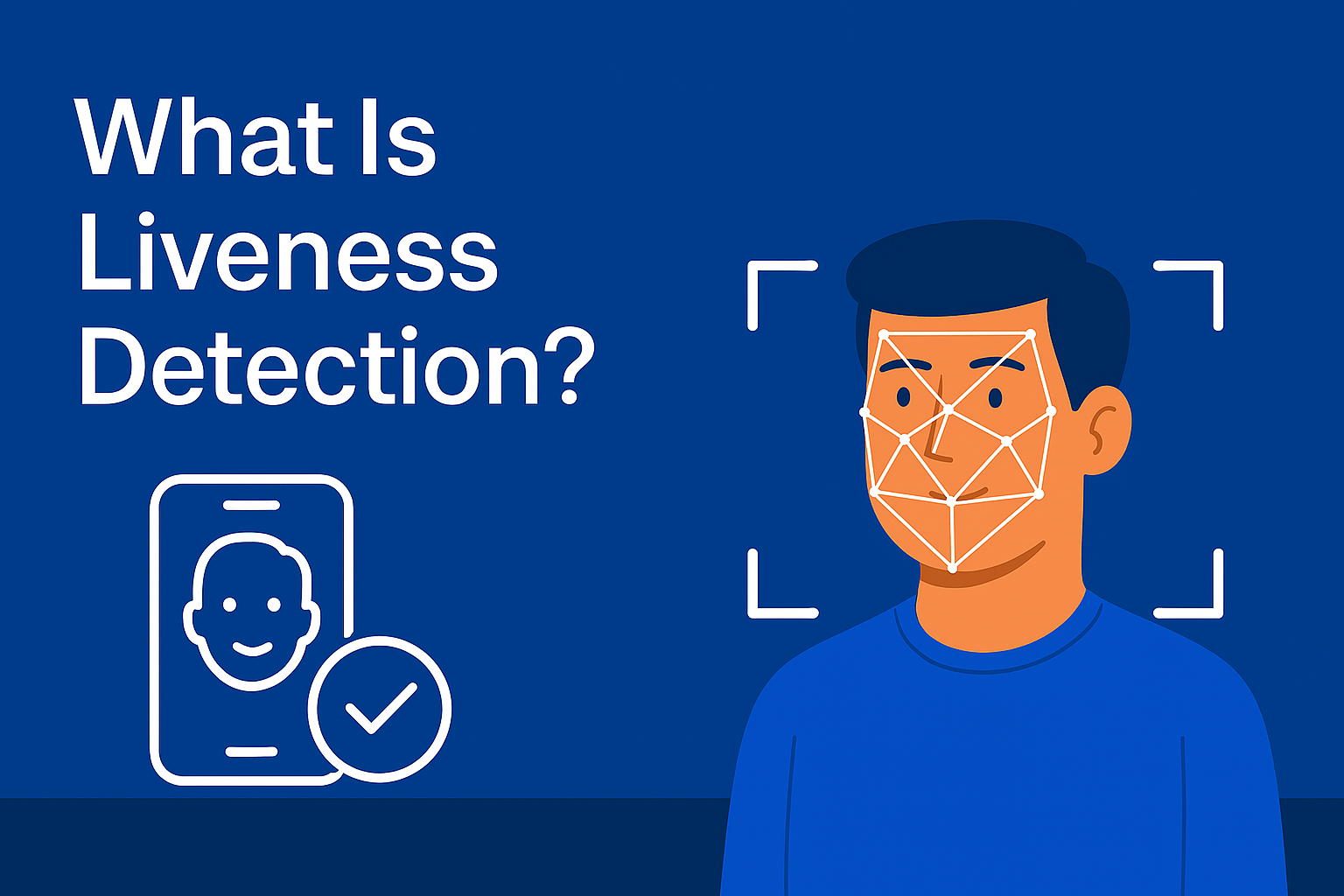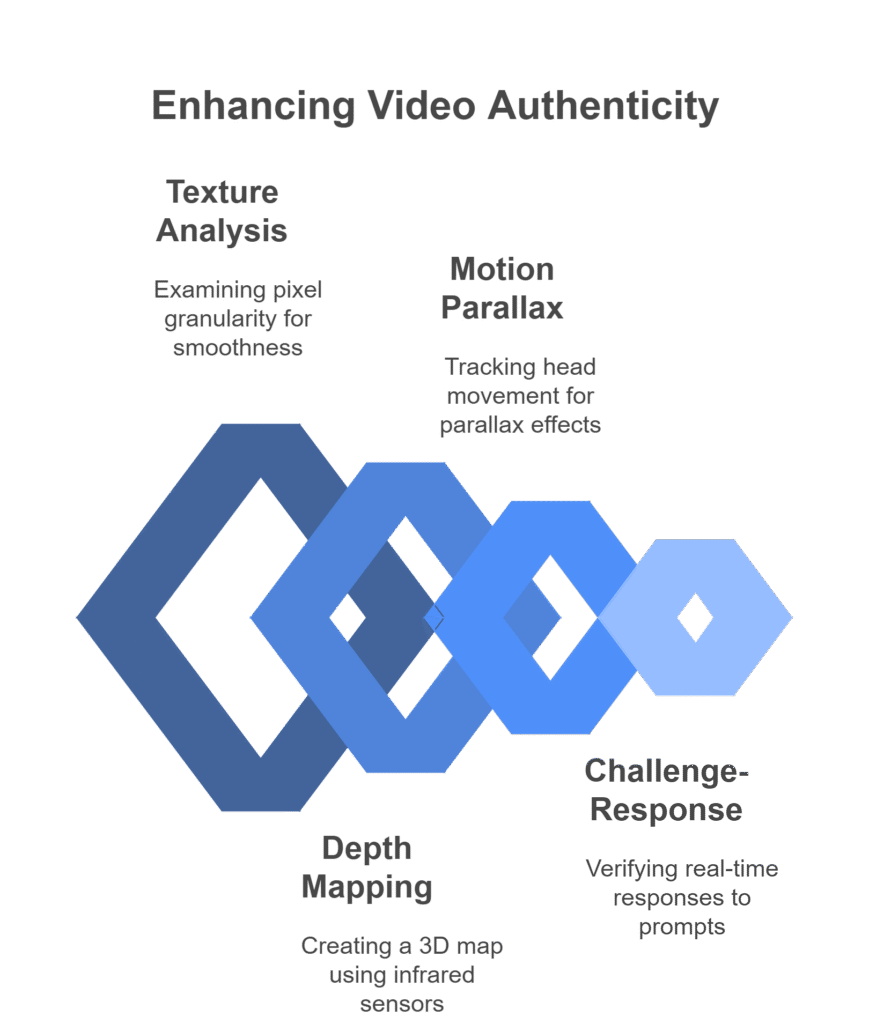
Every day more apps ask us to unlock accounts with a scan of our face or a tap of a fingerprint. It feels futuristic—until a fraudster waves a printed photo at the camera and sneaks right in. Liveness detection stops that trick. It proves that the person on camera is not a fake picture, a silicone mask, or a pre-recorded video.
Liveness Detection in One Sentence
Liveness detection is the process of confirming that a biometric sample—face, finger, palm, voice—is coming from a live human being right now, not from a spoof.
The first use of liveness detection was in 1950 by Alan Turing, the father of modern computing and computer science. This experiment was dubbed the Turing test, a test for intelligent behavior of a machine and its ability to produce answers similar to what a human would say. The test consisted of an evaluator, who is aware of the fact that one of the subjects in the conversation is not a human. The evaluator and machine subject communicated by typing on a keyboard. If the evaluator could not tell a human from a machine, the machine passed the test.
Types of Liveness Detection
There are two types of liveness detection – Active Liveness Detection and Passive Liveness Detection. Both differ in terms of user interaction.
We have seen some technology providers recently offer so-called semi-passive liveness detection checks. They attempt to create the optimal combination of both types of liveness detection to get the highest security and a good user experience. Specifically, in the so-called Smile Liveness, users are only asked to smile.
As technology continues to be more digital, we are seeing more and more instances of online identity fraud. Organizations and businesses are always looking for better security. One of the security measures to make remote identity verification more reliable is document liveness technology.
Passive Liveness Detection
What is passive liveness detection? In passive liveness detection, liveness detection runs in the background during the biometric facial verification process. Neural networks assess the components of the biometric sample (for example: a photograph taken by the enrolled user) such as light and shadows, skin texture, and various other important elements. The result is something that typically does not conclude with an alarm of adequacy, meaning it is more resistant to a spoof attack. So, passive liveness detection is the most user-friendly approach for the detection of a presentation attack.
As in some types of use cases, a level of engagement from the user is needed during the liveness check, there is an option for the biometric verification system to use so-called semi-passive liveness detection. The semi-passive liveness detection process is to increase the security of the onboarding process, while attempting to afford the best possible user experience. Semi-passive liveness detection prompts the user to perform an easy task (e.g., smiling) to verify liveness.
Active Liveness Detection
Active liveness detection is the true original form of liveness detection. It is a way to validate the source of the biometric sample as human versus a type of presentation attack. Liveness is detected by engaging a user by doing something simple like recording them while they consistently watch a moving object on a screen or follow or do some simple movement with their head.
The origination of active liveness was a video requiring the user to show their ID or do some movements in a recording. Active liveness checks today last seconds, and there is no longer a video. In technology today, active liveness captures and monitors the pupil movements of the subject where the assessment determination is identifying a spoof attack versus not spoofing the biometric sample.
Why Liveness Detection Matters?
In a world where we use our face to unlock our phone and our fingerprint to authorize payments, the necessity to protect biometric systems from counterfeit and forged identities is more pressing than ever before. As identity theft is increasingly becoming a worldwide issue, especially impacting the financial industry, businesses are changing from the traditional paper-based security to modern threats like deepfakes.
Liveness detection is one of the important components in an abuse pattern analysis in biometric security since it provides assurance that evidence the biometric originated from a living person in front of the scanner rather than from a photo, video, or mask. Businesses and organizations must implement liveness detection technology to secure private and sensitive information and preserve the trust of new and existing customers in the expanding cybersecurity space.
Why Should You Care?
- Fraud is rising. Deepfake software is cheap. Attackers can clone faces in minutes.
- Regulators demand stronger Know-Your-Customer (KYC). Financial rules now cite liveness detection as a required control.
- Users hate friction. A quick real-time check beats one-time passwords or in-person visits.
Put simply, liveness detection lets brands raise security while keeping logins smooth.
How Does Liveness Detection Work?
Engineers use three main approaches. Each looks for tiny cues that prove “I am alive.”
| Approach | What It Does | Common Signals | User Effort |
|---|---|---|---|
| Active Liveness | Prompts the user to respond. | Head turns, eye blinks, smile, spoken phrases. | Medium (user follows on-screen steps). |
| Passive Liveness | Runs silently in the background. | Skin texture, light reflections, micro-movements, 3-D depth. | Low (user does nothing extra). |
| Hybrid Liveness | Combines both for tough cases. | First passive scan; then an active prompt if risk is high. | Varies (only at higher risk). |
Developers feed these signals into a machine-learning model. The model scores the session: live or fake. If fake, access is blocked in milliseconds.
A Closer Look at Key Techniques

Texture Analysis
Live skin scatters light in a complex pattern. A printed photo looks flat. Algorithms study pixel granularity and flag anything that seems too smooth.
Depth Mapping
Infrared sensors project tiny dots on your face. The camera measures how far each dot bounces back, creating a 3-D map. A two-dimensional video can’t mimic that depth.
Motion Parallax
When you move your head, foreground and background shift at different speeds. Software tracks this subtle parallax to confirm real presence.
Challenge–Response
A prompt like “please blink twice” is hard to fake in real time. Even deepfake videos struggle to sync eyes and lips perfectly on demand.
Attacks That Liveness Detection Stops
| Attack Type | Typical Tool | Why It Fails With Liveness Detection |
|---|---|---|
| Photo Spoof | Printed or digital photo held to camera. | No depth, no micro-movement, texture mismatch. |
| Video Replay | Pre-recorded video on a phone/tablet. | Lack of correct challenge response; timing off. |
| Mask Impersonation | Silicone or 3-D-printed mask. | Skin-texture analysis and heat sensing expose fraud. |
| Deepfake Injection | AI-generated face fed into app. | Real-time prompt and device integrity checks stop static feed. |
Real-World Uses of Liveness Detection
- Mobile Banking: Verify identity during account opening and high-value transfers.
- Ride-Share Apps: Confirm drivers match the profile before each shift.
- E-Governance: Issue digital IDs without physical office visits.
- Age-Restricted Sales: Confirm a live adult is making the purchase.
- Physical Access Control: Secure doors in data centers or airports.
In each case, liveness detection reduces fraud and lowers the cost of manual reviews.
Benefits for Business and Users
- Stronger Security: Blocks over 99% of spoof attempts when tuned correctly.
- Lower Compliance Risk: Meets standards in GDPR, ISO/IEC 30107-3, and FinCEN guidance.
- Less Friction: Passive checks finish in under one second. Users barely notice.
- Scalable: Cloud and edge models handle millions of verifications daily.
- Audit Trails: Systems log confidence scores for later review.
Deployment Best Practices
- Use Multi-Modal Signals. Combine texture, depth, and motion for higher accuracy.
- Keep UX Short. Limit active prompts to two seconds to avoid dropout.
- Monitor Bias. Train models on diverse skin tones, ages, and lighting.
- Encrypt Every Frame. Video streams can carry sensitive PII; store them securely.
- Fail-Safe Paths. Offer secondary checks (OTP or human review) when liveness is inconclusive.
Common Myths, Busted
- “A high-resolution camera beats liveness detection.” Truth: Resolution helps, but without liveness checks, any feed can be spoofed.
- “Only big banks need this tech.” E-commerce sites, gig-economy apps, even dating platforms now adopt liveness detection to stop bots.
- “It slows login times.” Passive models add no visible delay; total flow stays under two seconds.
- “Deepfakes already beat liveness.” Cutting-edge liveness engines detect frame inconsistencies that deepfakes still can’t hide.
The Future of Liveness Detection
The next wave will lean on:
- Edge AI: Runs models directly on phones for faster, private checks.
- Sensor Fusion: Merges face, voice, and heartbeat data from wearables.
- Continual Learning: Updates models with fresh attack patterns in real time.
- Zero-UI Security: Completely invisible checks that run as you pick up your device.
As spoof tools grow smarter, liveness detection will stay one step ahead with deeper analytics and cross-sensor data.
Quick Recap
- Definition: Liveness detection proves a biometric sample comes from a living person right now.
- Need: Stops photo, video, mask, and deepfake attacks.
- Methods: Active, passive, or hybrid AI checks using texture, depth, motion, and prompt responses.
- Benefits: Better security, compliance, and user experience with minimal friction.
Final Thoughts
As the world leans toward passwordless logins and digital onboarding, liveness detection is not a ‘nice to have’ anymore. It is the silent protectors, securing our biometric future while being real, safe and easy for the user. By understanding the meaning of liveness detection and using it properly, organizations can protect accounts, reduce fraud loss and provide users a seamless sign in experience, all while keeping ahead of increasingly sophisticated spoofing strategies.
References:





